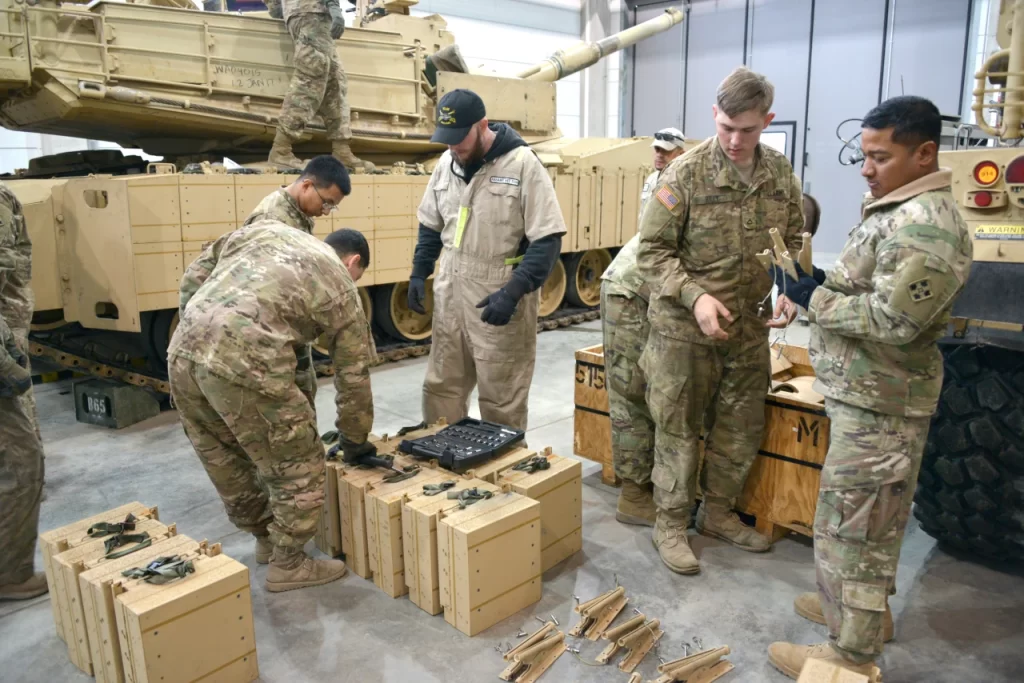A video on Social Media by Ukrainian sources on January 14th suggests that the M1A1 Abrams main battle tanks delivered by the US as aid to Ukraine have received armour improvements. This modification intends to improve the M1A1 main battle tanks’ defensive capabilities against emerging threats on the Ukrainian battlefield. The M1A1 main battle tank’s sides are equipped with M-19 Reactive Armour Tiles or ARAT, an upgraded armour solution that gives more effective protection in combat scenarios, particularly against shaped charges and explosively formed projectiles (EFPs) commonly encountered in urban warfare
These tanks were delivered as part of the United States’ military assistance to Ukraine. The first set of these tanks arrived in Ukraine in 2023 and went into service.
The footage suggests that the ARAT dynamic protection has been mounted on a tank’s “aprons,” which generally cover the hull. They are not found in other critical regions, such as the turret’s frontal and side extensions or the hull’s front. These positions, on the other hand, are intended to accommodate such protection units.

The US uses Tusk or the Tank Urban Survivability Kit for the M1A2 Abrams tank. One of the parts of the kit is the ARAT, meant for the side aprons of the hull.
M1A1SA Abrams
To speed delivery and match Ukraine’s limited technical and logistical support capabilities, the decision was taken to provide M1A1 tanks rather than the more modern M1A2. The M1A1 Abrams main combat tank is outfitted with complex composite armour called Chobham armour for protection. This armour is a mixture of materials such as ceramics and metal alloys, and the US military classifies the actual “recipe” for the armour. Nonetheless, it is well known for providing strong protection against anti-tank weaponry. Chobham armour is an important part of the M1A1 Abrams main combat tank, contributing to increased protection.
The M1A1SA Abrams is an upgrade to the M1A1 developed in the late 1990s. They incorporate many M1A2 Abrams features, such as an improved fire control system with thermal imaging for the gunner and commander; CITV for enhanced situational awareness for the commander; CWS for independent engagement by the commander; an upgraded armour package offering better protection against anti-tank weapons; and digital communications and situational awareness systems.
In short, the M1A1SA is a modernised M1A1 with increased firepower, armour, and combat awareness. There are further M1A1SA variations, such as the M1A1SA M1 Abrams SEP or the System Enhancement Package, with even more advanced features.

M-19 Abrams Reactive Armor Tile/ARAT
Now, returning to the topic. The American M1A1SA Abrams tanks, like their Ukrainian equivalents, have reactive armour only on the side “aprons.” It’s worth noting that M1A1SA Abrams tanks were initially delivered to Ukraine without dynamic protection systems, much like Bradley infantry fighting vehicles.
Ensign-Bickford Aerospace & Defense, or EBAD, produces the M-19 Reactive Armour Module, which symbolises cutting-edge armour technology. This reactive armour module blends EBAD’s patented insensitive energetic material with passive components, boosting armour protection capabilities dramatically. It is also lighter than standard steel reactive armour. The new design incorporates a box-like material with explosive charges between two metal surfaces. This design greatly increases the vehicle’s survivability against various threats, reducing personnel losses and boosting the vehicle’s mission capabilities.
M19 modules are normally mounted on the hull’s side skirts. Each side has 32 cassettes fitted. They can also be put on the turret’s sides and the turret’s and hull’s front armour. These configurations are rarely utilised in practice but can be implemented if necessary. In the TUSK-1 variant, ARAT-1 kits are placed on tanks separately or as part of a larger Tank Urban Survivability Kit.
For M1A1 and M1A2 tanks, ARAT-2, which can be assembled separately or as part of a broader TUSK-2 kit, has also been developed. ARAT-2 adds new M32 modules with a distinctive shape resembling tiles or the Scutum shield used by Roman legions. M32 cassettes are mounted on M19 modules on the fuselage sides, providing a multi-layered reactive shell. It’s worth noting that the M19 already features a multi-layered design. M32 modules are fitted independently on the turret sides, giving extra protection against shaped charge projectiles. The modules’ specific settings and the level of security they can give are unclear. Each side of the hull has 32 M32 cassettes, while each side of the turret has 11 modules.

Since 2006, the United States Army has completely outfitted the M-19 Reactive Armour Module to meet the damage danger that heavy tanks confront in Iraq. The M-19’s modular and lightweight design enables manual installation and easy deployment and customisation in response to changing battlefield conditions or unique mission needs. It can be applied to various vehicle elements, including the hull, skirts, and turret, to provide greater protection against shaped charge threats, which is useful in urban combat.
Notably, M-19 technology is very dependable and has a proven safety track record in training, field, and combat settings. Its upkeep is simple, as it requires no power connection or sensor positioning, and installation is similar to handling ammo, making storage simple. The design minimises collateral harm by guaranteeing that neighbouring modules do not detonate in sequence when attacked, redirecting the response to impending threats through rigorous analysis and testing. This armour system meets the US military standard MIL-STD2105IM criteria and has been extensively tested against light weapons to demonstrate its resistance to bullet and fragment impacts.

